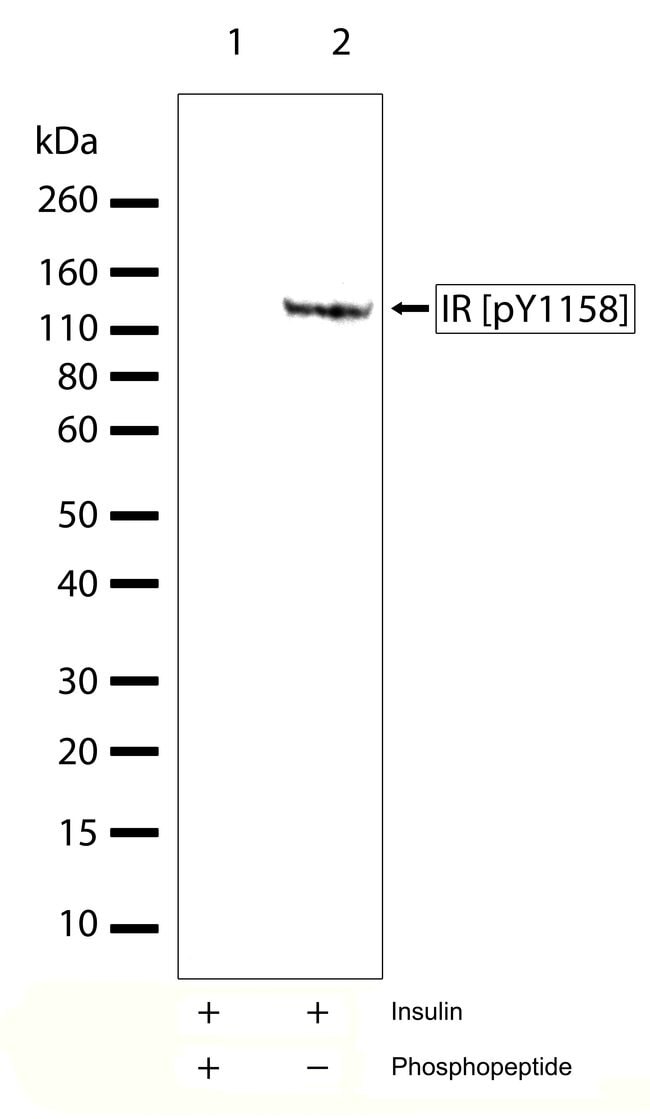Anti-Insulin Receptor (phospho Y1158) antibody [8HCLC] (ab277763)
Key features and details
- Produced recombinantly (animal-free) for high batch-to-batch consistency and long term security of supply
- Rabbit recombinant multiclonal [8HCLC] to Insulin Receptor (phospho Y1158)
- Suitable for: ICC, IHC-P, WB
- Reacts with: Human
Overview
-
Product name
Anti-Insulin Receptor (phospho Y1158) antibody [8HCLC]
See all Insulin Receptor primary antibodies -
Description
Rabbit recombinant multiclonal [8HCLC] to Insulin Receptor (phospho Y1158) -
Host species
Rabbit -
Tested applications
Suitable for: ICC, IHC-P, WBmore details -
Species reactivity
Reacts with: Human -
Immunogen
Synthetic peptide corresponding to Human Insulin Receptor aa 1153-1162 (phospho Y1158).
Database link: P06213 -
Positive control
- ICC: HeLa cells. IHC: Human skeletal muscle tissue. WB: HeLa whole cell lysate treated with Insulin.
-
General notes
Recombinant multiclonals are a mixture of recombinant antibodies co-expressed from a library of heavy and light chains.
Recombinant multiclonal antibodies offer the sensitivity of polyclonal antibodies by recognising multiple epitopes, along with consistency of a recombinant antibody.
Properties
-
Form
Liquid -
Storage instructions
Shipped at 4°C. Store at +4°C short term (1-2 weeks). Store at -20°C long term. Avoid freeze / thaw cycle. -
Storage buffer
Preservative: 0.09% Sodium azide
Constituent: 99.91% PBS -
 Concentration information loading...
Concentration information loading... -
Purity
Protein A purified -
Clonality
Recombinant Multiclonal -
Clone number
8HCLC -
Isotype
IgG -
Research areas
Images
-
 Immunohistochemistry (Formalin/PFA-fixed paraffin-embedded sections) - Anti-Insulin Receptor antibody (ab277763)
Immunohistochemistry (Formalin/PFA-fixed paraffin-embedded sections) - Anti-Insulin Receptor antibody (ab277763)Immunohistochemistry analysis of Phospho-IR pTyr1158 showing staining in the cytoplasm of paraffin-embedded human skeletal muscle tissue (right) compared to a negative control without primary antibody (left). To expose target proteins, antigen retrieval was performed using 10mM sodium citrate (pH 6.0), microwaved for 8-15 min. Following antigen retrieval, tissues were blocked in 3% H2O2-methanol for 15 min at room temperature, washed with ddH2O and PBS, and then probed with ab277763 diluted in 3% BSA-PBS at a dilution of 1/20 overnight at +4°C in a humidified chamber. Tissues were washed extensively in PBST and detection was performed using an HRP-conjugated secondary antibody followed by colorimetric detection using a DAB kit. Tissues were counterstained with hematoxylin and dehydrated with ethanol and xylene to prepare for mounting.
-
Immunofluorescence analysis of Phospho-IR pTyr1158 was performed using 70% confluent log phase HeLa (Human epithelial cell line from cervix adenocarcinoma) cells treated with 10 nM Insulin for 10 minutes. The cells were fixed with 4% paraformaldehyde for 10 minutes, permeabilized with 0.1% Triton X-100 for 10 minutes, and blocked with 2% BSA for 1 hour at room temperature. The cells were labeled with ab277763 at 2 μg/mL in 0.1% BSA and incubated for 3 hours at room temperature and then labeled with Goat anti-Rabbit IgG (H+L) Superclonal Secondary Antibody, Alexa Fluor 488 conjugate a dilution of 1/2000 for 45 minutes at room temperature (Panel a: green). Nuclei (Panel b: blue) were stained with SlowFade Gold Antifade Mountant with DAPI. F-actin (Panel c: red) was stained with Alexa Fluor 555 Rhodamine Phalloidin (1/300 dilution). Panel d represents the merged image showing cytoplasmic localization. Panel e shows untreated cells with no signal. Panel f represents control cells with no primary antibody to assess background. The images were captured at 60X magnification.
-
All lanes : Anti-Insulin Receptor (phospho Y1158) antibody [8HCLC] (ab277763) at 1 µg/ml
Lane 1 : HeLa (Human epithelial cell line from cervix adenocarcinoma) whole cell lysate treated with Insulin (100 ng/mL, 15 min)
Lane 2 : Preincubation with the phosphopeptide, HeLa whole cell lysate treated with Insulin (100 ng/mL, 15 min)
Predicted band size: 156 kDa
-






![Anti-Insulin Receptor (phospho Y1158) antibody [8HCLC] (ab277763)](https://www.abcam.com/ps/products/277/ab277763/Images/ab277763-5-benefits-of-recombinant-antibodies.jpg)

